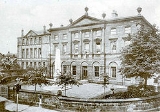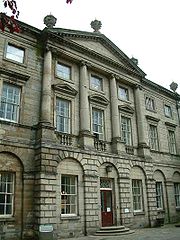
St Helen's House, Derby
Encyclopedia
St Helen's House is a Grade I listed building situated in King Street, Derby
, England
. It has been used in the past as a private residence and as an educational establishment. Currently disused, it is planned to reopen the building as a hotel.
architect
Joseph Pickford
for John Gisborne, an alderman
of Yoxall Lodge, Staffordshire, in the Palladian
style, and originally stood in 80 acres (323,748.8 m²) of parkland. Although the interior has been altered, the facade remains intact. It has been described by the Georgian Group, of London, as "one of the finest and largest eighteenth century townhouses to survive in any provincial city".
. In 1840 it was the birthplace of Henry Strutt, 2nd Baron Belper
. The first Lord Belper sold the house to the governors of Derby School
in 1863.
. During WWII Derby School was evacuated first for a short period to Overton Hall, Ashover and then from June 1940 until July 1945 at Amber Valley Camp, Woolley Moor. The school returned in September 1945 and remained there for another 21 years until 1967. The school was then moved to the Moorway Lane site in Littleover in 1967, but the house and adjoining building, the Pearson Building, known as 'B' Block to old pupils remained in public ownership, first as the home of the Joseph Wright School of Art and from 1972 as an Adult Education centre. Due to the deterioration of the fabric, these uses were also moved and the building became vacant.

During 2008 and 2009 the building was made wind and weather proof by the new owner and generally tidied up and modern educational equipment removed. Due to the present economic climate (2011) the hotel development was placed on the 'back burner' and in July 2011 a revised planning application to change the use of the two buildings in King Street into high quality offices was submitted.
The local BBC Radio Station in 2008 broadcast an in depth programme including interviews with Richard Blunt and this may be both seen and heard by going to the Old Derbiean Society website at www.oldderbeians.org and also into BBC Radio Derby archives.
Derby
Derby , is a city and unitary authority in the East Midlands region of England. It lies upon the banks of the River Derwent and is located in the south of the ceremonial county of Derbyshire. In the 2001 census, the population of the city was 233,700, whilst that of the Derby Urban Area was 229,407...
, England
England
England is a country that is part of the United Kingdom. It shares land borders with Scotland to the north and Wales to the west; the Irish Sea is to the north west, the Celtic Sea to the south west, with the North Sea to the east and the English Channel to the south separating it from continental...
. It has been used in the past as a private residence and as an educational establishment. Currently disused, it is planned to reopen the building as a hotel.
Construction
The house was built about 1766-67 by the EnglishEngland
England is a country that is part of the United Kingdom. It shares land borders with Scotland to the north and Wales to the west; the Irish Sea is to the north west, the Celtic Sea to the south west, with the North Sea to the east and the English Channel to the south separating it from continental...
architect
Architect
An architect is a person trained in the planning, design and oversight of the construction of buildings. To practice architecture means to offer or render services in connection with the design and construction of a building, or group of buildings and the space within the site surrounding the...
Joseph Pickford
Joseph Pickford
Joseph Pickford was an English architect, one of the leading provincial architects in the reign of George III.-Biography:Pickford was born in Warwickshire in 1734 but he moved as child to London when his father died. Pickford's initial training was undertaken under the stonemason and sculptor...
for John Gisborne, an alderman
Alderman
An alderman is a member of a municipal assembly or council in many jurisdictions founded upon English law. The term may be titular, denoting a high-ranking member of a borough or county council, a council member chosen by the elected members themselves rather than by popular vote, or a council...
of Yoxall Lodge, Staffordshire, in the Palladian
Palladian architecture
Palladian architecture is a European style of architecture derived from the designs of the Venetian architect Andrea Palladio . The term "Palladian" normally refers to buildings in a style inspired by Palladio's own work; that which is recognised as Palladian architecture today is an evolution of...
style, and originally stood in 80 acres (323,748.8 m²) of parkland. Although the interior has been altered, the facade remains intact. It has been described by the Georgian Group, of London, as "one of the finest and largest eighteenth century townhouses to survive in any provincial city".
Strutt family
During the 19th century, the house was the home of the Strutt family, including Edward Strutt, 1st Baron BelperEdward Strutt, 1st Baron Belper
Edward Strutt, 1st Baron Belper PC, FRS , was a British Liberal Party politician. He served as Chancellor of the Duchy of Lancaster from 1852 to 1854 under Lord Aberdeen.-Background and education:...
. In 1840 it was the birthplace of Henry Strutt, 2nd Baron Belper
Henry Strutt, 2nd Baron Belper
Henry Strutt, 2nd Baron Belper PC, JP, DL , styled The Honourable Henry Strutt between 1856 and 1880, was a British businessman, courtier and politician...
. The first Lord Belper sold the house to the governors of Derby School
Derby School
Derby School was a school in Derby in the English Midlands from 1160 to 1989. It had an almost continuous history of education of over eight centuries. For most of that time it was a grammar school for boys. The school became co-educational and comprehensive in 1974 and was closed in 1989...
in 1863.
Educational uses
Between 1863 and 1966 (apart from five years during the Second World War), the house was occupied by Derby SchoolDerby School
Derby School was a school in Derby in the English Midlands from 1160 to 1989. It had an almost continuous history of education of over eight centuries. For most of that time it was a grammar school for boys. The school became co-educational and comprehensive in 1974 and was closed in 1989...
. During WWII Derby School was evacuated first for a short period to Overton Hall, Ashover and then from June 1940 until July 1945 at Amber Valley Camp, Woolley Moor. The school returned in September 1945 and remained there for another 21 years until 1967. The school was then moved to the Moorway Lane site in Littleover in 1967, but the house and adjoining building, the Pearson Building, known as 'B' Block to old pupils remained in public ownership, first as the home of the Joseph Wright School of Art and from 1972 as an Adult Education centre. Due to the deterioration of the fabric, these uses were also moved and the building became vacant.

Planned conversion
In November 2006, St Helen's House (Block 'A') and the Pearson Building (Block 'B') was sold by Derby City Council to property developer Richard Blunt on a 299 year leasehold. Originally it was proposed to convert the two buildings into a fifty-room hotel, and to construct an apartment block within a crescent where the current Chapel, gymnasium and craft workshops stand. Planning permission was granted in 2009.During 2008 and 2009 the building was made wind and weather proof by the new owner and generally tidied up and modern educational equipment removed. Due to the present economic climate (2011) the hotel development was placed on the 'back burner' and in July 2011 a revised planning application to change the use of the two buildings in King Street into high quality offices was submitted.
The local BBC Radio Station in 2008 broadcast an in depth programme including interviews with Richard Blunt and this may be both seen and heard by going to the Old Derbiean Society website at www.oldderbeians.org and also into BBC Radio Derby archives.

